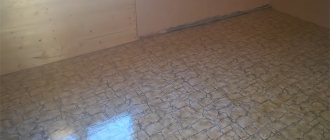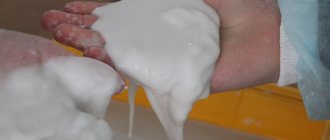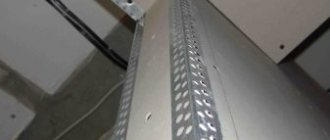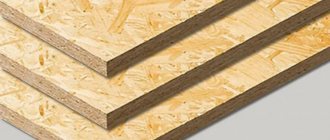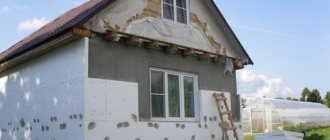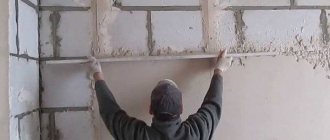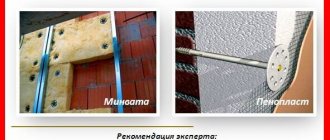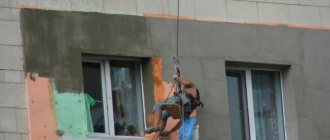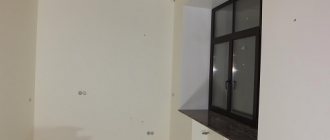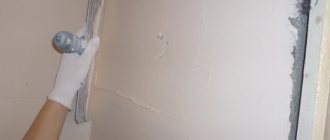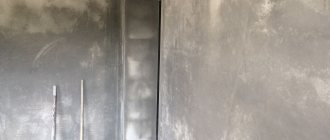7902 0 0
Andrey November 2, 2016Specialization: facade finishing, interior finishing, construction of dachas, garages. Experience of an amateur gardener and gardener. We also have experience in repairing cars and motorcycles. Hobbies: playing the guitar and many other things that I don’t have time for :)
Puttying foam plastic is one of the most important stages of wall insulation, since not only the appearance of the finish, but also its durability depends on it. In addition, do not forget that putty protects the insulation from mechanical stress. Therefore, in this article I decided to tell you how to putty polystyrene foam with reinforcing fiberglass mesh with your own hands.
Applying putty over foam
Putty for foam plastic - selection and application
Reinforcement is a technological process aimed at obtaining additional or improving existing properties of a material or product. Let's consider the reinforcement of a material such as polystyrene foam. To understand why it is necessary to reinforce foam plastic, let’s remember: what kind of material is it? Foam plastic is a plastic mass obtained by foaming polystyrene granules. In the construction sector, foam plastic is used for finishing facades and for insulating premises for all types of operational use. To extend the life of foam plastic without losing its physical and chemical properties, it is often necessary to make the surface of foam sheets smoother, harder, and suitable for finishing. This is where reinforcement comes into play. In the first case, when we need a smoother surface of the foam sheets, we putty the sheets. How do we putty the foam? For puttying polystyrene foam, retail chains offer a wide range of mixtures that have the same basic properties, but also differ in composition and places of application (for rooms with high or low humidity, etc.), it follows that for puttying foam plastic, the putty mixture must be selected taking into account the conditions operation of the premises.
Advantages of this procedure
Polystyrene foam is used for finishing the external (less often - internal) walls of houses to insulate the room. Putty is usually applied over the slabs, as this provides the following advantages:
- Its thermal insulation properties are preserved for a long time.
- The material becomes stronger, the risk of damage is greatly reduced. If left unprotected, the granules will swell and stick together in high summer temperatures. From cold weather, on the contrary, it will become even more fragile, and with minimal damage it will simply crumble.
- Fire retardant properties increase - sensitivity to high temperatures and the risk of fire are reduced, although the foam itself is very flammable. Modern high-quality putties contain substances that prevent the penetration of fire.
- Obstacle to moisture penetration. Although the foam is not afraid of water, it still gets wet and then takes a very long time to dry. This noticeably reduces its thermal insulation properties, and when exposed to damp for a long time, its structure is destroyed and increased fragility appears.
- Protection from ultraviolet rays and gusts of wind. In the open sun, the surface will turn yellow, the material will begin to crumble excessively, and a strong wind can even tear off part of the insulation.
- Preparing the wall surface for finishing, improving its appearance.
Important
Before applying putty, the surface of the slabs must be primed with a special mixture for polystyrene foam or PVA glue.
What does puttying do?
Foam putty will not only improve the quality of the subsequent finishing, but will also provide the following:
- Strengthening. The material breaks easily under mechanical stress, for example, an unsightly hole can form upon impact. The putty protects against such influences.
- Preservation of thermal insulation qualities. Moisture is not dangerous for penoplex, but due to the low vapor permeability of the material, trapped moisture particles from the foam structure take a long time to be removed, which has a bad effect on the ability to retain heat.
- Increasing fire retardant qualities. Expanded polystyrene is very flammable, and the applied putty will serve as an additional way to reduce the risk of fire.
- Protection from wind and sun. Even if interior decoration is carried out, it is impossible to completely avoid exposure to sunlight on the material, and they have a destructive effect on the foam structure.
But how to choose a putty solution so that it has maximum protective qualities?
Choosing putty for foam plastic
Due to its qualities: reliable thermal insulation, light weight, immunity to moisture, mold and mildew, expanded polystyrene has found application in many areas of construction production.
Polystyrene foam cladding is an effective way to insulate walls. The polymer is characterized by increased fragility and is destroyed by ultraviolet irradiation and exposure to atmospheric phenomena (rain and wind), so covering walls with foam plastic requires external protection.
Foam putty is the product that protects the insulation.
Why do you need wall cladding with polystyrene foam?
Polystyrene foam insulates the walls of a house well
The walls and ceilings inside buildings are finished with polystyrene foam, and the facades of buildings are also covered with this material. Sheets of polymer are attached to concrete and brickwork with umbrella dowels.
We recommend: Painting on wet plaster or how to make a fresco yourself
Since the material cannot withstand even average loads from fasteners, the dowels have a radial plastic extension (umbrella) in the upper part.
Polystyrene foam contributes to significant insulation of the enclosing structures of buildings and structures.
Foam sheet sizes
For cladding facades and internal walls, slabs measuring 1.2 m x 0.6 m with a thickness of 20, 30, 40 and 50 mm are used.
For external work, foam plastic with a thickness of 40 and 50 mm is used.
The internal surfaces of the walls are lined with slabs 20 and 30 mm thick.
Technology of covering walls with polymer insulation
Dowel-umbrella
Before starting work, prepare the following tools and materials:
- insulation boards;
- umbrella dowels;
- metal, fiberglass or plastic reinforcing mesh;
- perforator;
- construction knife;
- roulette.
Installing foam sheets on vertical internal fences of a house does not cause any particular difficulties:
- mark the location of expanded polystyrene sheets on the wall;
- additional elements are made by cutting solid foam slabs;
- polymer sheets are secured with umbrella dowels in the corners and in the center of the plane.
It is optimal to use glue or umbrella dowels for installing panels
Coating building facades with polymer slabs is somewhat different from cladding the walls of premises:
- The bases of the facades (monolithic concrete, brickwork or wooden frame) are coated with an adhesive primer.
- The insulation sheets are installed with special glue.
- For more reliable fastening, the foam is fixed with dowels - umbrellas.
- A reinforcing mesh is glued on top. The mesh can be metal, plastic or fiberglass.
Scheme of wall decoration inside and outside the building.
In some cases, it is possible to install facade insulation without glue on dowels, which ensure reliable fastening of the insulation. The surface of the insulation has weak adhesion, so the polymer coating of the walls must be puttied.
Preparation of putty
Stir the mixture until the lumps disappear
Prepare the adhesive mixture in the following order:
- The dry mixture is slowly poured into a clean container filled with water. In this case, the solution is stirred all the time. This is done with a wooden spatula or a drill with a screw attachment.
- If the mixture is prepared using a drill, then it is turned on at reduced speed. This guarantees a homogeneous mass without lumps.
- Under no circumstances should dry powder be added to the finished putty. This will cause hard lumps to form. This kind of putty cannot be used.
- After receiving the finished mixture, it should be allowed to stand for 5-10 minutes.
- Then the solution is finally mixed.
Puttying foam
The question of how to putty polystyrene foam does not differ much from the treatment of surfaces made of other materials. The retail chain always has a special putty for expanded polystyrene on sale. The material is mainly sold in the form of a dry mixture. For more information about reinforcing and filling foam, see this video:
Coat the foam with primer
Before puttingtying the foam, it is coated with a primer. Inside buildings, polystyrene foam putty can be done with an adhesive composition intended for ceramic tiles.
This cannot be done outside on the facades of buildings. To do this, use a special putty on polystyrene foam for exterior work. Leveling compounds for interior and exterior work are not interchangeable.
Puttying the polystyrene coating is carried out as follows:
- Apply the prepared solution with a spatula. For work, use a set of blades of different widths. Depending on the complexity of the work and the adhesive composition, metal, plastic and rubber spatulas are used.
- First, fill all the seams and joints between the foam sheets with mortar.
- A special tape is glued to the joints with a width slightly larger than the vertical and horizontal seams. The tape is a small plastic grid.
- The width of the tool is selected for processing certain areas of the surface.
- After the joint joints have completely dried, they proceed to puttying the entire surface. Using a narrow spatula, transfer the glue to a wide spatula.
- Apply the product in semicircular movements with a wide spatula from top to bottom. A narrow spatula is used to treat hard-to-reach and inconveniently located places.
- The thickness of the layer of adhesive composition depends on the angle of inclination of the spatula in relation to the treated surface of the polystyrene cladding. The greater the angle of inclination, the thinner the coating layer.
The quality of polystyrene foam filling directly depends on the experience of the worker. Professional work will not require finishing the evenness of the plane. Minor blemishes in the finishing can be removed using sandpaper.
We recommend: All about tile grout - rating of the best manufacturers and a 4-step guide to choosing
Finishing of foam cladding
You can trim putty foam with sheets of fiberboard or chipboard
The final finishing of putty polystyrene boards differs for interior walls and building facades.
The final finishing of internal fences is that any type of decor can be laid over a well-prepared layer of putty. There is no need to do any additional work. Wallpaper is glued onto the finished putty surface, sheets of fiberboard, chipboard are installed, or decorative plaster is rolled on.
For the external walls of the facade, putty polystyrene foam boards must be further strengthened. Despite the fact that the facade insulation is fixed with dowels, a reinforcing grid is glued to the walls to securely fasten the decor.
The grate is coated with a primer and puttied with a product intended for outdoor use.
After this, the surface of the facade is finished with decorative plaster or other materials. To see what can happen if the foam is not finished correctly, watch this video:
If you decide to use ceramic tiles for finishing, then, as in the case of finishing facades on foam plastic, a reinforcing grid is glued.
The process of plastering foam plastic: stages of work
There are several steps to follow. But first you will need to prepare the tools: a plaster grater, a drill with a mixer, a painting mesh, a building level, sandpaper for grouting, a spatula and a trowel. Consumable materials will require plaster mixture, primer, decorative plaster (mineral or acrylic). Now you can move on to the work itself.
Plastering foam plastic: stages of work
Leveling the base
Before you putty the foam base, you need to carry out some preparation. Initially, you need to level the level of all joints between the panels, for which you use a rule or a wide spatula. Such differences must be eliminated first, since this defect cannot be eliminated using mixtures.
The joints are removed using polyurethane foam. This material allows you to achieve maximum tightness. As soon as the foam has dried, its excess is cut off with a stationery knife. After this, the surface is cleaned of dirt and passed several times with a needle roller. Thus, the adhesion of materials is increased and the mixture will adhere better to the foam.
Sealing joints and seams
Preparation of the solution
For beginning builders, it is better to pay attention to universal mixtures (glue-plaster). This solution is used both for fixing foam plastic to the wall and for plastering. The companies Ecomix and Ceresit have proven themselves to be excellent.
For processing 1 sq.m. the surface requires approximately 4 kg of mixture. Each package contains instructions from the manufacturer. For this stage, any plastic or metal container is used, and the stirring itself is best done using a drill with a “mixer” attachment. This will not only create a uniform consistency of the solution, but will also significantly save effort and time on mixing.
Advice! Professional craftsmen recommend preparing a solution of a thinner consistency for gluing the reinforcing mesh than that specified in the instructions. This will allow all pores on the foam to be treated, and therefore increase the adhesion of materials.
Installation of plaster mesh
In order for the plaster to adhere securely to the foam, a reinforcing mesh is pre-installed on it. This layer provides protection against cracking and provides additional surface strengthening.
Preparation of materials and tools
Since foam insulation is most often carried out outside, first we will look at what and how to putty it on the street. Very often on the Internet you can find advice that you need to use simple tile adhesive or other mixtures. But why do this? If you have a vacuum cleaner, you won't sweep with a mop. Foam putty is commercially available specifically for this purpose. For example, an excellent option is Ceresit ST85 or Ceresit ST83.
This is a dry mixture that can be used for both external and internal work. The material is universal and has won the trust of many. In addition to the putty itself, the following materials are needed:
- polyurethane foam;
- primer;
- corners for reinforcement;
- fiberglass mounting mesh. It is important to understand that it can be for interior or exterior use.
Now let's look at the list of relevant tools:
- clean container (bucket, basin);
- drill mixer;
- roulette;
- rule;
- wide, narrow and medium spatulas;
- stationery knife;
- foam grater.
When the entire arsenal is assembled, you can start working.
How to prepare the surface
Make sure that the wall you are applying the putty to is plastered or made of a cementitious material. Take additional measures to prevent dampness, mildew, fading, etc. Make sure the surface is completely clean. It must be free of dust, particles, paint residues, grease, oil, wax or any other contaminant.
Remove all material from the wall that is no longer holding well. This can be done using sandpaper or a wire brush, and then wipe. Wet the wall with enough clean water and let it dry before you putty the walls. Make sure the surface is not wet, but not dry, but damp. Avoid over-wetting which will cause water to accumulate on the surface.
What kind of putty is needed for polystyrene foam: tips for selection and use
Foam putty is used to make the surface of the insulating layer more resistant to external influences. In addition to putty, foam primer is also used for the same purposes. If these products are applied correctly, the material will retain its basic properties and gain additional properties that are valuable in construction terms.
Why do you need to trim the foam?
Puttying polystyrene foam is a prerequisite in the process of insulating a room with this material. But, auxiliary finishing of polystyrene foam surfaces is not always used. It all depends on the method of attaching the insulation. If the foam is attached to the wall using construction umbrellas and glue, then puttying is used. Other fastening methods completely exclude this finishing method.
The foam itself is very fragile, so it needs additional protection, which can be achieved using special finishing mixtures - primers and putties.
Finishing materials in this direction are necessary for:
- reducing the risk of mechanical damage;
- minimizing exposure to moisture;
- hiding foam from exposure to direct ultraviolet rays;
- improving the aesthetic appearance of insulating material;
- formation of an adhesive base between all layers of finishing;
- smoothing out temperature differences.
The primer is the fastening link between the surface of the foam and further layers of the finishing coating. Puttying is necessary in order to eliminate defects in the surface of the foam and prepare it for painting or decorative plaster.
On video: how to insulate a house with polystyrene foam.
What kind of putty is needed?
How to putty foam? Success depends on choosing the right putty material. The composition of this mixture can be different: prepared independently or purchased ready-made. The store sells putty mixtures for polystyrene foam, which just need to be diluted with water in the appropriate proportion.
This product is of high quality if you use certain brands that have earned a reputation over the years. The manufacturing company Ceresit can boast of an optimal ratio of quality and price.
When choosing a material, you should pay attention to the following characteristics:
- Area of application of putty. It can be for external and internal use.
- Manufacturer's recommendations indicated on the packaging. Here are instructions for preparation and use. Some brands require special operating conditions, which relate to air humidity and temperature conditions.
- For exterior work, a regular sand-cement mixture is often used. A reinforced mesh holds this layer on the surface of the foam.
- For interior finishing work of this type, reinforcing mesh is not used; special glue is required.
We recommend: How to putty chipboard
In order for the choice of finishing material to be correct, you should carefully select the product: establish the correct storage conditions and service life. Under no circumstances should the mixture be used for outdoor use indoors and vice versa.
If you take into account all the quality conditions when choosing construction products, the mixture will serve as an ideal coating for many years. Otherwise, the putty will peel off and crack within a short time after application.
Preparatory work
In addition to the correct choice of finishing material, it is necessary to make appropriate preparations for work: collect the necessary tools and prepare mixtures and products. Preliminary cleaning of the wall is also necessary.
First you need to collect all the necessary equipment:
- reinforcing mesh made of plastic or metal;
- dry putty;
- a certain type of primer;
- wide and narrow spatulas;
- construction mixer for preparing the mixture;
- roller and paint brushes;
- construction float with clamps.
First, the wall surface is prepared for attaching foam blocks or sheets. After installation of expanded polystyrene, a primary primer is performed. This procedure will eliminate the appearance of mold and mildew in the thickness of the finishing material and increase the adhesion of the finishing materials. Afterwards plastering is carried out using reinforcing mesh. And only after that they do the puttying.
Puttying process
Many inexperienced builders have a completely correct question: how to putty polystyrene foam? How to do it correctly, and most importantly, efficiently? The process consists of several main steps and processes that guarantee a good result. This is how façade putty is applied to polystyrene foam:
1. After the surface has been primed, plastering is carried out using an abrasive mesh. The mesh must be completely covered with plaster. When the finishing layer has dried, it should be sanded using a float. Sanding is best done about a day after applying the plaster.
2. Sanding (grouting) must be done efficiently so that no obvious defects or irregularities are visible. Putty is applied to such a base, which is considered the finishing base for painting.
3. Apply the prepared mixture onto a wide spatula with another small spatula, and rub the material over the surface of the wall with smooth circular movements. The layer should not exceed 3 millimeters. Puttying is carried out in separate sections.
4. At the end, the finishing finishing layer is grouted. A construction float is used for this. Such work should be carried out no earlier than every other day, but no later than 4 days. It is important not to overdry the final layer, since when grouting such material there may be a problem with individual parts breaking off.
After the work on strengthening the foam is completed, secondary priming and finishing with decorative plaster will be carried out. The secondary primer is chosen to be based on quartz grains, making it more suitable for strong adhesion. This is followed by finishing with decorative plaster and painting with facade paint.
If everything is done correctly, the reinforcing and decorative layers will last for a very long time - the service life is at least 5 years under optimal conditions. The main thing is to choose high-quality building materials and carry out preparatory and construction work correctly.
In addition to aesthetic preferences, the technical side regarding putty is also determined.
Preparatory work
We found out whether it is possible to putty the insulating layer. Now we suggest you figure out how to do this correctly. Craftsmen claim that placing insulation on a wall surface does not require additional work.
The algorithm of actions is as follows:
- First of all, using the rule, the evenness of the base is assessed. Identified bumps and other uneven areas are rubbed with a special foam grater. As a rule, irregularities form at the joining areas of the sheets;
- the existing cracks in such places become foamy. Such work is considered mandatory, because polyurethane foam prevents the formation of cold bridges that reduce the quality of insulation. In the absence of foam, the cracks are sealed with the remains of the foam material;
- slope and corner areas are reinforced with perforated corners, fixed to the surface with an adhesive mixture. During installation work, use a level that allows you to achieve horizontal and vertical evenness;
- All that remains of all the preparatory activities is to prepare a putty mixture, with the help of which the joints between the sheets of insulation and the dowel heads are sealed.
To putty polystyrene foam, you must have certain skills.
The surface of the sheets is roughened, after which they are treated with a primer mixture to enhance adhesion. All that remains is to fix the reinforcing mesh and begin applying the putty mixture.
